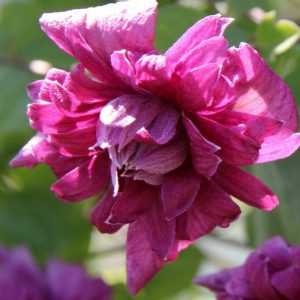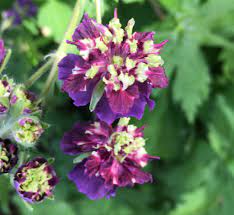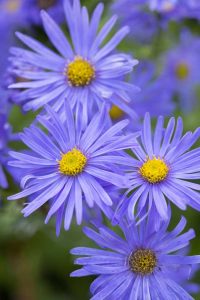Diva or dependable? That is the question…
As many of you know I’m wedded to my garden, my little corner of paradise in the Cotswolds. In late spring and summer, my sixty or so peonies open and the brashest of all is a lemon-yellow Itoh peony named ‘Bartzella’. The huge, flouncy flowers have led the Best Beloved, a man whom prefers a gentle way of life, to christen this meringue of a peony ‘Godzilla’ instead. In full flight, it’s a showstopper and the only flower in our garden that has persuaded a local artist to take up her brush. The handsome leafy canopy is greatly appreciated by our ginger tomcat, Frank, who uses it as parasol or umbrella – depending on the weather. It’s said that Birdlip enjoys four seasons in one day. We have just the two for most of the year – winter and spring – after all this is Cold Aston.

Itoh peonies, such as ‘Bartzella’ are hybrids between tree peonies and herbaceous peonies. Their handsomely dissected foliage, pointed buds, woodier stems and larger flowers are inherited from the tree-peony. Their herbaceous nature, tuberous roots and floriferous habit come from their Chinese Paeonia lactiflora parent. Itohs are fairly recent, having appeared within the last forty years or so. At first, they were prohibitively expensive and the first pieces of ‘Bartzella’ fetched some $1000 dollars, roughly £500 back then. They’re now very affordable, although their sizable flowers and handsome demeanour demand a prominent position and space. They are not for the faint-hearted.
These hybrids were a plant breeding challenge because the Japanese nurseryman after whom they’re named, Toichi Itoh, made 1,200 crosses from the 1940s onwards. He failed more often than he triumphed, but finally managed to raise 36 seedlings. Mr Itoh died in 1956, before his treasures flowered. His son-in-law, Shigao-Oshida, carried on looking after them though and by 1963 several were blooming. The story could have ended there and then, but for an American tree peony enthusiast named Louis Smirnow. He spotted their potential and persuaded the family to let him patent the best seedlings and take them to America.
News of their arrival provoked great excitement in the peony world and prompted American breeders to take up the baton. ‘Bartzella’ was raised and named by Anderson in 1986, but I also admire his lilac-pink ‘First Arrival’ (1986), his magenta-pink ‘Morning Lilac’ (1999) and the pink-flushed white ‘Cora Louise’ (1986). All three got AGMs (Award of Garden Merit) in the recent RHS Wisley Peony Trial, although the coppery browns and butterscotch Itoh peonies ( and there are many) didn’t fare so well because they tend to luck mucky!

‘Bartzella’ is definitely a diva, no question. It makes a great splash, but generally it’s only for a week or three. Gardeners need long-stay plants that go on week after week, as well, and many do this because they can’t be pollinated successfully so don’t set any viable seeds. In other words they’re sterile and this can happen for several reasons. The most obvious one is double flowers that are full of petals and nothing else. Extra petals have usually replaced stamens and style, so these flowers do nothing to help pollinators. Plant breeders work hard to produce doubles, because they know the flowers will last for far longer, and many roses, dahlias and garden pinks are double-flowered for this very reason. I am very fond of two double viticella clematis, the dusky pink ‘Purpurea Plena Elegans’ (always known as PPE for short) and ‘Mary Rose’, a double navy-blue that has recently been re-named C. viticella ‘Flore Pleno’. Their flowers open in July, but persist into September, purely due to being double.

I have one double plant in my garden that knowledgeable garden visitors (ones who really know their plants) are attracted to like bees round a honey pot. It’s a double form of Geranium phaeum, an early-flowering geranium bearing sprays of dainty flowers. ‘Joseph Green’ has frilly purple flowers studded with lime-green anthers. It will flower for almost three months and always looks fresh and pretty. Try Avondale Nursery near Coventry. www.avondalenursery.co.uk
Other long-flowering hardy geraniums are also sterile due to being hybrids between two closely related genera. This causes a pollen incompatibility and that prevents seeds from being formed, even after bees have visited, so the poor thing carries on flowering in vain. Geranium ‘Rozanne’, voted the Plant of the Centenary at the 100th Chelsea Flower Show held in 2013, is a good example.

This geranium appeared in Donald and Rozanne Waterer’s Crooked Acre Garden in Somerset in 1989. At that time the Waterers, who has retired from their family nursery which specialised in azaleas, growing between 25 to 30 different hardy geraniums. Their non-stop pale-blue seedling geranium, thought to be a hybrid between G. himalayense and G. wallichianum ‘Buxton’s Variety’, flowered from June until November. The Waterers contacted Adrian Bloom of Bressingham Plants and ‘Rozanne’ was launched at Chelsea Flower Show in May 2000. It does form a wide mound, so it needs space, and some gardeners cut it back in May to delay the flowering season and limit the size. ‘Azure Rush’ is similar, but with paler flowers.
Not all sterile hardy geraniums appear by serendipity. Alan Bremner, a farmer on Orkney, bred hardy geraniums using traditional plant breeding methods, using a paintbrush and tweezers. He transfers pollen between species, making careful records. In 1992 he produced a black-eyed magenta named ‘Patricia’ which is hardly ever out of flower. It has inherited the flower colour and upright habit of a May-flowering hardy geranium species, G. psilostemon, but the addition of G. endressii has made ‘Patricia’ flower for far longer. ‘Patricia’ will also tolerate some shade and the darkly-veined vibrant flowers go on for weeks. I’ve used it close to roses, but it would be stunning among silver foliage. ‘Ivan’ is similar, but with larger flowers. ‘Dragon Heart’ is a shorter version with similar flowers.

If you prefer a long-flowering paler pink for the front of a sunny border, seek out G. ‘Mavis Simpson’. This was a chance geranium seedling found at the Royal Botanic Gardens at Kew in 1982. Mavis worked in the alpine section and this low-growing geranium has soft, grey-green foliage indicating a need for a sunny position and good winter drainage. Here it begins in June and is often still flowering in November. Or you could use ‘Orion’, a cobalt-blue hardy geranium that forms lax, but well-behaved mounds of finely dissected foliage topped with deep-blue flowers. This was discovered by Dutch nurseryman Brian Kabbes and is thought to be a cross between ‘Brookside’ and G. ibericum. This is earlier to flower, beginning in May and lasting through summer. If you can cut Orion down to nothing in July, it will reshoot within a week and go on to produce a later crop of flowers.

August is brightened by two daisies and both keep their pristine flowers for many weeks, however dry it is. The crisply neat brown-eyed, golden-yellow daisies of Rudbeckia fulgida var. deamii, commonly known as Deam’s sunflower, cannot be bettered and this profuse flowerer also has dark-green foliage. The other daisy, Aster x frikartii ‘Mönch’, begins to produce lavender daisies on slightly lax stems in July and then it just keeps on going. It’s also very drought tolerant because this European hybrid aster is a 1924 cross between A. amellus (the Italian aster) and A. thomsonii, a Himalayan species that’s thought to be lost to cultivation. Frikart named several, but Aster expert Paul Picton thinks that there’s no difference between Mönch’ and ‘Wunder von Stäfa’. Both were named after Swiss mountains and there is also a ‘Jungfrau’ and an ‘Eiger’. Frikart, a Swiss nurseryman, named these in 1924 and just like out Japanese peony breeder, Toichi Itoh, he struggled to produce viable seedlings at first. Thank goodness they did succeed, for we dependable good doers as well as divas.



